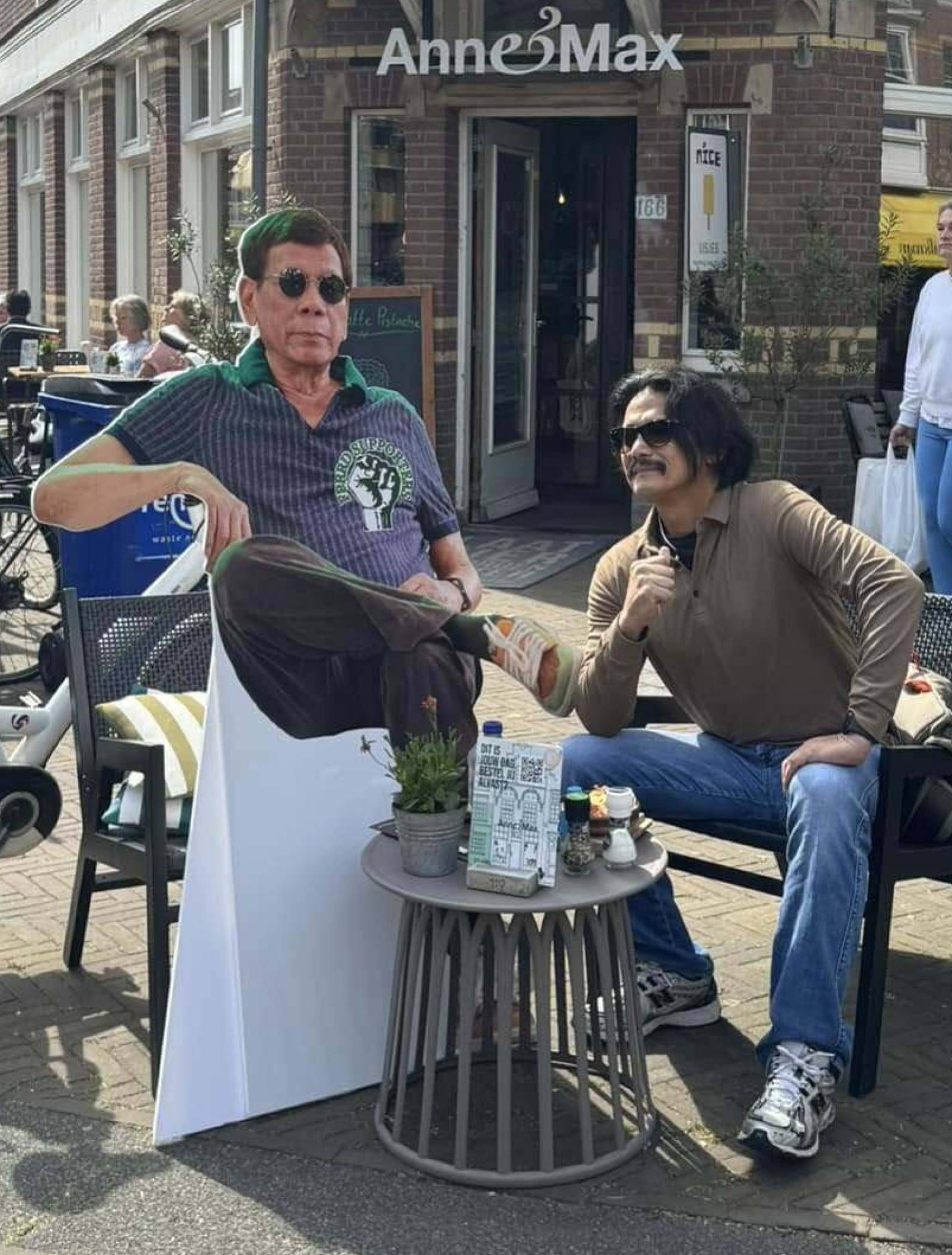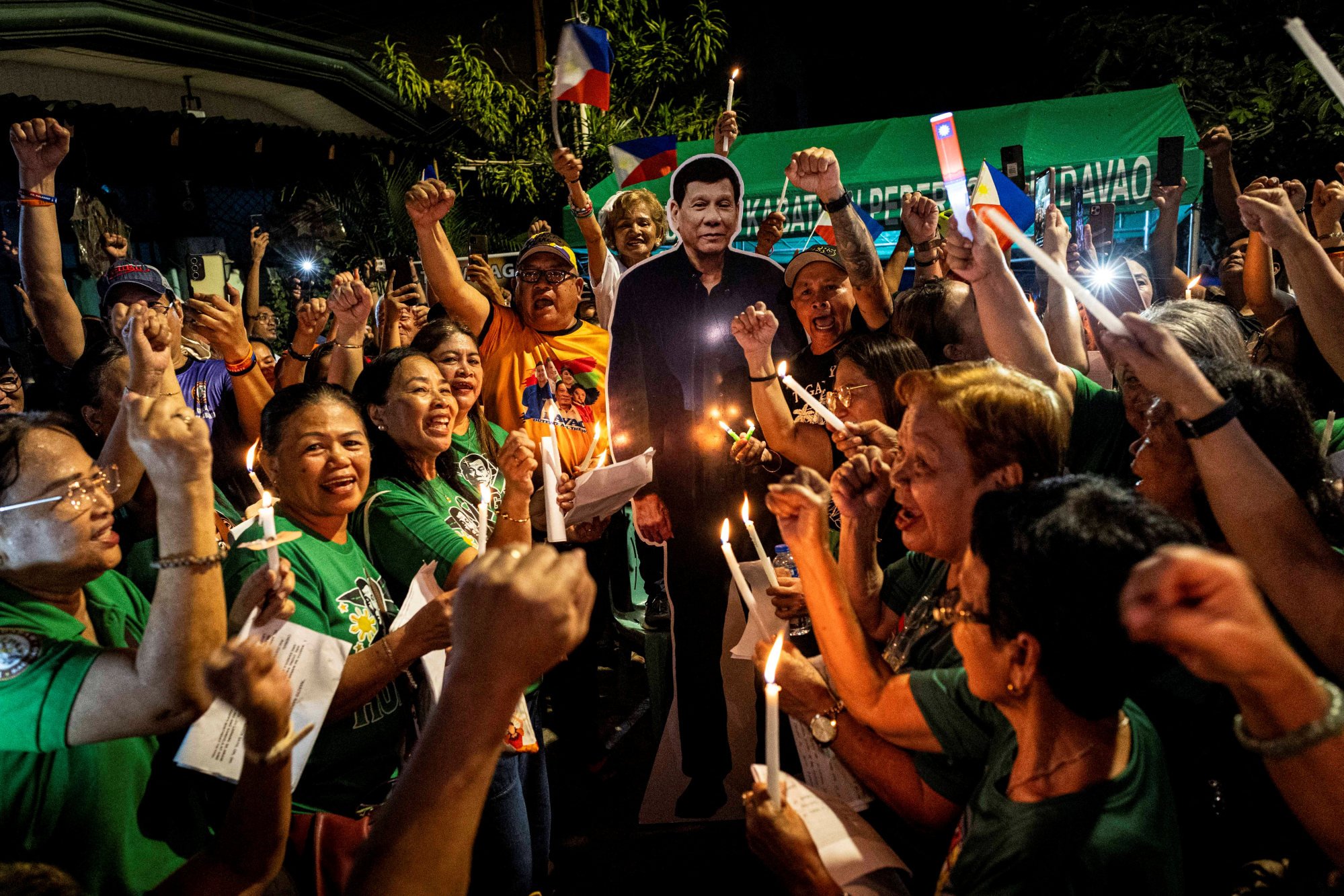Why Duterte’s diehard fans are carrying cardboard cut-outs around The Hague
The life-size standees have been seen around the Philippines and The Hague, where the former president is in ICC detention

It’s morning in The Hague and Senator Robin Padilla is wandering around looking for a place to eat – while carrying a life-size full-colour cardboard cut-out of Rodrigo Duterte.
Settling down at an outdoor cafe, the Filipino political partisan props the standee beside him. The cardboard image of the former president depicts him seated, wearing dark glasses and a T-shirt. Padilla, president of the Duterte-controlled PDP Laban party, snaps a photo for his social media account.
To some, this scene may appear surreal – but not to the other Filipinos nearby, who are arriving in town with their own standees in tow.
In one video, a middle-aged Filipino woman rides a speeding tram while clutching a Duterte standee. She glances back at the bemused passengers, smiles and says earnestly: “This is our president.”
Duterte, 80, is being held at the International Criminal Court’s detention centre in Scheveningen, The Hague’s seaside resort district. He is set to face trial this year for crimes against humanity related to his administration’s “war on drugs”.

Since his transfer from Manila to The Hague in March, his supporters in Europe – mostly overseas workers – have regularly gathered in the city, holding rallies that call for his release and extol his supposed virtues. Occasionally, they are joined by Duterte’s family members, including daughter Sara and son Sebastian, along with allies like Padilla who fly in from Manila.
Lately, these followers have taken to bringing standees of their idol, having their pictures taken with images of the man they call “Tatay (Daddy) Digong”.
The cut-outs serve as a substitute for the real thing. “Standee na lang muna” (a standee will have to do for now), as one social media post summed it up. Although the real Duterte may be confined, his cardboard counterparts are proliferating outside.
Duterte ran for Davao mayor in the May 12 general election and won by a landslide. Now, critics on Facebook joke that with the winning candidate locked up, a standee might have to stand in as mayor.
Supporters have been using Duterte cut-outs as far back as 2016, when the Davao strongman ran for president. Other politicians have also made use of standees.
“When [Duterte critic] Leila de Lima ran for the Senate, she was still in jail so they had a standee of her on stage,” recalled a prominent retired advertising executive, who asked to remain anonymous.
The former ad executive told This Week in Asia that “politicians will use anything that will get attention, so the use by them should not be surprising”.
“Since the advent of cellphones, snapping one’s photo with a standee of someone you admire – or even detest – and posting the same with a comment is fairly common.”
Die-cut for the diehards
But there’s nothing common about the ways in which Duterte’s fans are using their standees.
The cut-outs have popped up not just in the Netherlands but also in the Philippines. Last month, a rally supporting Duterte in his hometown, Davao, featured a long procession of motorcyclists led by a vehicle with a life-size cut-out standing upright on its roof.
Women admirers have recorded themselves talking to the cut-outs, dancing with them and even kissing the cardboard figures.

“I would never say it’s not normal because there’s always a variety of ways we show support and express political opinion,” said Dr Anna Christina Tuazon, an associate professor in the University of the Philippines’ psychology department.
She told This Week in Asia that “it makes more sense if you view them as fans, their relationship with the idol outside politics”.
This phenomenon is called a “parasocial relationship” – a one-sided psychological connection with an idol, as though it were a genuine relationship. “That’s why they take it personal what happens to Duterte. This is someone they have a very strong intimate bond with,” Tuazon said.
But the truth is, “Duterte doesn’t really know who they are – just like a celebrity doesn’t have a social relationship with his fans”.
She noted how in the Philippines “the political dynasties in general really cultivate that parasocial relationship with their constituents, they make it seem like they really care. In the Filipino way. I’m your family, your tatay”.
One photo from Davao shows a standee being prayed to by candle-holding followers. When asked if this was similar to the use of religious icons, the former ad executive replied: “I would not liken it to processions with statues as those have been part of long religious or cultural traditions among Filipino Catholics. I think the intention is to spread the feeling that Digong is here and present in the country.”

Duterte standees, crisply printed in various poses and outfits, do not come cheap. “Standees are expensive to produce because they are die-cut, and must be durable to withstand wear and tear – there is nothing worse than a stained, torn or wrinkled standee. They can also be easily stolen by overeager fans,” the ad executive said.
For the less discerning, however, more affordable options are available. In Manila, a custom-made life-size cut-out costs 1,800 pesos (US$32) with free delivery on Lazada, which is part of Alibaba Group, the Chinese e-commerce conglomerate that owns the South China Morning Post.
A print shop in the Netherlands will knock one out for less than €30 (US$34). Walmart in the US actually offers a Duterte cut-out in a blue suit for US$89.97.
“People who snap photos with standees of ‘celebrities’ are most likely fans,” the ad executive said. “And certainly, many fans are somewhat fanatic. Can’t discount cultists, for sure.”